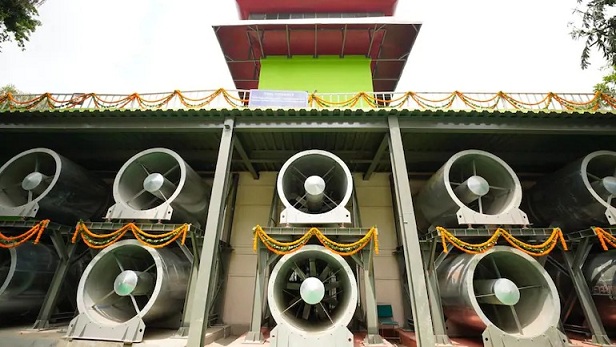Chief Minister Arvind Kejriwal on Monday inaugurated the “country’s first smog tower” at Connaught Place in Delhi.Many such structures can be installed in the national capital if this pilot project yields results, he said.
“This is the first such smog tower in the country with a new technology. We have imported it from the US. The structure will suck polluted air from above and release clean air from below. It will purify 1,000 cubic metres of air per second,” Mr Kejriwal told reporters.
The smog tower has 40 fans and 5,000 filters developed by experts at the University of Minnesota, which also helped design a 100-metre-high smog tower in Xian, China.
According to reports, the experimental tower in northern China has brought a noticeable improvement in air quality.
A Delhi government statement said the 24-metre-high smog tower at Connaught Place, one of the biggest commercial centres in the capital, is based on a downdraft air-flow model.
Its 40 huge fans will suck air from the top of a special type of canopy structure and release clean air filtered through novel geometry filters, it said.
Since it is a new technology, it is being implemented on an experimental basis. Tata Projects Limited (TPL) built the smog tower with technical support from IIT-Bombay and IIT-Delhi, which will analyse its data. NBCC India Ltd is the project management consultant, Mr Kejriwal said.
“The experts will analyse the functioning of the smog tower and tell us if it is effective. If it is successful, many such smog towers can be installed across Delhi. If not, we will work on some other technology… I think it will prove to be a path-breaking milestone,” he added.
In November 2019, an expert panel estimated that the capital will need 213 such anti-smog towers.
“Data analysis will start immediately. The initial trends will be available within a month… I am also excited to know if we succeeded or not,” the chief minister said, adding that a detailed performance report will be ready within two years.
Delhi Environment Minister Gopal Rai said the smog tower will “operate at full capacity” after the monsoon season.
The chief minister said the concentration of PM2.5 has reduced from around 150 micrograms per cubic metre to 100 µg/m³ and that of PM10 has dipped from around 300 µg/m³ to 150 µg/m³ in the national capital since 2014 due to the efforts made in the last few years.
PM2.5 refers to fine particles which penetrate deep into the body and fuel inflammation in the lungs and respiratory tract, leading to risks of cardiovascular and respiratory problems, including a weak immune system.
“IQAir”, a Switzerland-based air quality technology company that measures air quality levels of selected cities based on PM2.5 concentration, ranked Delhi the world’s most polluted capital for the third straight year in 2020.
Kejriwal had in 2019 likened the capital, which gets enveloped in poisonous haze every winter, to a “gas chamber”.
Following this, the Delhi cabinet approved the smog tower project in October last year.
A two-year pilot study will ascertain the effectiveness of the smog tower. A control room has been set up at the site to monitor its operations, an official said.
Another 25-metre-tall smog tower, built by the central government at Anand Vihar, is expected to become fully operational by September 7.
The Delhi Pollution Control Committee is the nodal agency for the smog tower at Connaught Place, while the Central Pollution Control Board is the nodal agency for the one coming up at Anand Vihar.
The Supreme Court in January last year had directed the central government to construct a smog tower to reduce pollution at Anand Vihar and the Delhi government to install another such structure at Connaught Place in three months.
Experts, however, feel smog towers may provide immediate relief from air pollution in a small area but they are a costly quick-fix measure with no scientific evidence to back their efficacy in the long term.
Governments should instead address root causes and promote renewable energy to tackle air pollution and reduce emissions, they said.
It will be really unfortunate if other cities decide to follow suit and set up these expensive, ineffective towers. They are an enormous distraction from what should be the governments’ focus, reducing emissions, Santosh Harish, a fellow at the Centre for Policy Research, said.
While smog towers might come across as a visible solution to air pollution, there is no scientific evidence — even globally — to support that they can filter outdoor air effectively, added Tanushree Ganguly, programme lead at the Delhi-based Council on Energy, Environment, and Water (CEEW).

